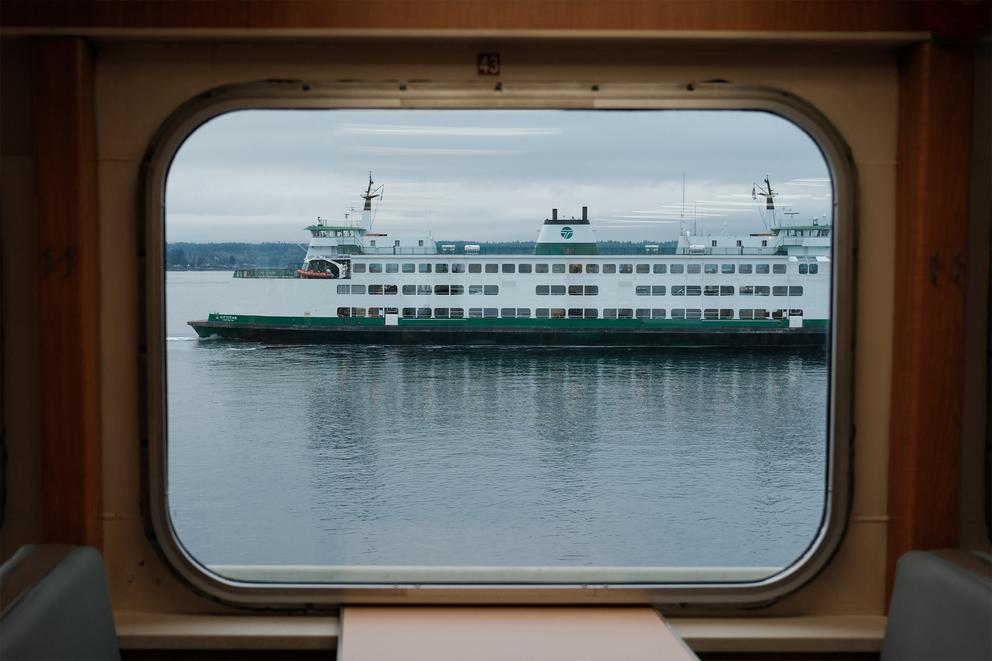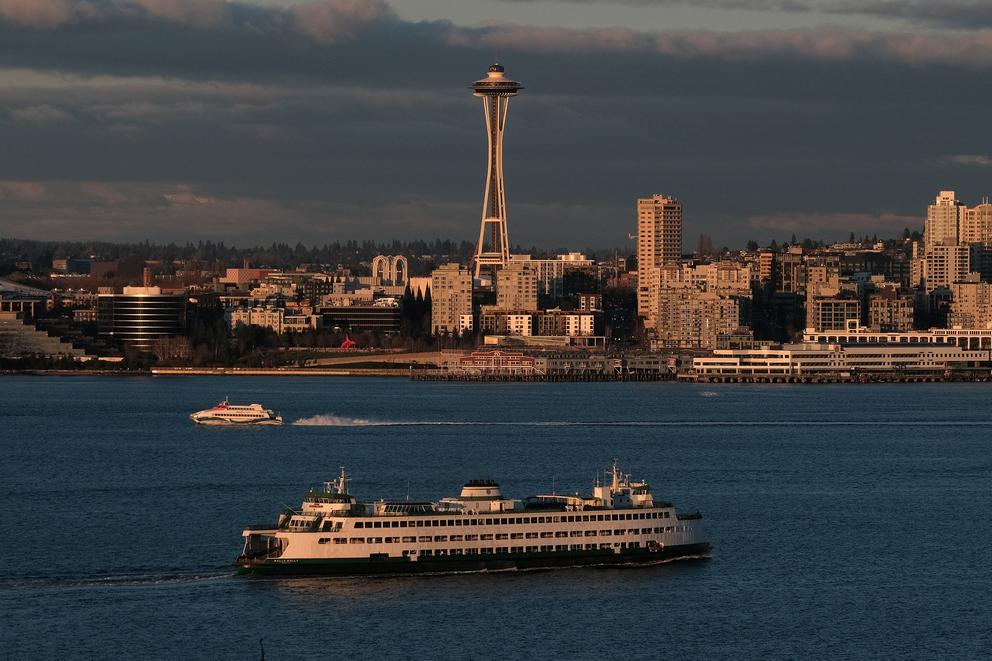This year, the Washington State Ferries system has guaranteed money from the program to revamp two of its biggest ferries from purely diesel vessels to electric/diesel hybrids that would be more efficient and pollute less, said Sen. Marko Liias, D-Edmonds, chairman of the Senate Transportation Committee, at a briefing earlier this year.
Additionally, there is a chance that the initial bidders this year might offer to convert three – instead of two – diesel ferries into hybrids. Liias said the cap-and-invest program could provide as much as an extra $200 million to ensure that a three-vessel overhaul contract could be signed, depending on what the final bids turn out to be.
While opposing the idea of the cap-and-invest program, Sen. Curtis King, R-Yakima, the ranking minority member on the transportation committee, agreed that there was consensus on commitment to the ferry program this year.
Washington’s cap-and-invest program, which raises money by limiting the amount of statewide emissions and selling extra capacity to fossil-fuel-burning companies, has been criticized by opponents who, debatably, link the program to increases in gas prices and utility rates. But the money raised also finances numerous climate change programs across the state that include building bike lanes, replacing old buses and ferries with new electric ones and other projects that mitigate the impact of pollution on local communities.
After a conservative-backed initiative campaign, Washington’s voters will decide in a November referendum whether they want to keep or eliminate this program. If the cap-and-invest program is revoked, legislators will have to rethink their transportation priorities, including how to fit ferry projects in the overall plans.
Liias said a repeal of the Climate Commitment Act, which includes the cap-and-invest program, would be “devastating” to the state’s infrastructure plans.
“If the Climate Commitment Act is repealed, the need to fund ferries doesn’t go away. We’d have to cut other spending because these new vessels are critical to the fleet. All transportation projects are connected – when funding for something essential disappears, others have to be put on the chopping block to make up the gap. This means that repeal of the CCA will likely impact maintenance, preservation, and our ability to complete projects on time all across the state,” Liias told Cascade PBS in an email. “It’s too early to say exactly how we’ll move forward. … A repeal would be devastating and leave us with only bad and worse choices.”
However, King said if the cap-and-invest program is repealed, it will have collected money by the end of 2024, which could be used, if needed, for converting all three of the state’s biggest ferries, plus provide some cushion if the 2024 bids turn out to be higher than expected.
Also, Republicans have proposed shifting some revenue from vehicle sales taxes to the transportation budget, if needed for ferries or other infrastructure projects, he said.
Meanwhile, Inslee spokesman Mike Faulk said the governor’s office is focused on the current supplemental budget negotiations in the Legislature, and that it is premature to map out a ferry Plan B if the cap-and-invest program is repealed.
Future of the ferries
The ferry investments outlined by Liias last week are just the beginning for the Washington State Ferries system. It is in the early stages of a massive overhaul that will expand and revamp most of the fleet by 2040 and beyond. WSF aims to expand from 21 to 26 vessels by 2040, with 22 of the boats being hybrid diesel/electric, reducing the fleet’s carbon footprint by 76%.
This overhaul will both update the struggling fleet of old and outdated vessels and tackle Gov. Jay Inslee’s long-range push to trim carbon emissions in Washington.
Currently, the WSF is struggling to keep its 10 routes that criss-cross Puget Sound fully functional. The system needs 19 vessels during its peak usage period and 17 during the off-season. Eight years ago, the ferry system had 24 boats, but three have since been sold after they reached the lifespan for which they were designed. The oldest vessels are 64 years old. With some ferries being maintained or under repair, the fleet usually has 16 to 18 vessels in service at a time.
“They were old then and older now. … We have an urgent need for new vessels,” said Matt von Ruden, the WSF’s electrification program administrator.
Drinking up to 18 million gallons of diesel fuel a year, the ferry fleet is the state government’s largest emitter of carbon dioxide. The ferry system’s overhaul is supposed to trim the fleet’s emissions by 50% by 2033 prior to meeting its 2040 target of 76%.
Last year, to help open the number of facilities available to build ferries as well as to increase competition, the Legislature passed a law that allows Washington to use out-of-state shipyards to build ferries.
The WSF already has been in contact with shipyards in Washington, California, Florida and the Gulf Coast that would be interested in building these ships. The contracts will go to the lowest bidder, but Washington shipyards will get an advantage of 13% of their bids.
Since ferries are not oceangoing ships, any built outside of Washington would be lifted onto a cargo ship to be transferred to Puget Sound.
The plan is to have 22 hybrids in the fleet by 2040 along with four existing 144-vehicle Olympic vessels serving the San Juan Islands. The replacement of the final four diesel ferries after 2040 has not been mapped out yet.
Here is the plan:
Converting six diesel ferries into hybrid diesel-electric boats
The three biggest ferries are 202-vehicle Mark IIs. Right now, the Mark II vessel Wenatchee is being converted into a hybrid at Seattle’s Vigor Shipyard. Instead of its current four diesel engines, it will be returned to duty by October with two battery-driven engines and two backup diesels.
The Tacoma will be converted next by fall 2025, followed by the Puyallup if money is available. So far, Washington State Ferries has spent almost $35 million of the $140.6 million allocated by the Legislature, in a 2022 transportation package, for the conversions of the Wenatchee and the Tacoma. Gov. Jay Inslee has asked for $50 million in this year’s supplemental budget to overhaul the Puyallup.
Meanwhile, three Kwa-di Tabil-class ferries – the smallest in the fleet, which are capable of carrying 64 vehicles – will be converted next.
Building five new hybrid vessels
The ferry system hopes to award one or two contracts on building five new 144-vehicle hybrid ferries, to be completed by 2030.
So far $14.8 million in preparatory work has been done, with the 2022 transportation package allocating $1.1 billion to these five vessels.
Upgrading ferry terminals with electric chargers
Ultimately, 16 terminals will be upgraded so the electric vessels will have a place to charge. So far, $101.7 million in revenue from Washington’s cap-and-invest program has been allocated for five such terminals in Seattle and on Bainbridge island. “We plan to charge two large ferries in downtown Seattle simultaneously without the lights dimming on the [Pier 57] Carousel,” von Ruden said.
The terminals in Bremerton, Clinton and Kingston will follow, with the Southworth-Vashon-Fauntleroy triangle being next. Because the triangle route is short, likely only one terminal will be electrified to serve that route, von Ruden said.
WSF’s master schedule calls for:
- The Seattle-Bainbridge route to be partly electrified later this year and fully electrified by 2027.
- The Seattle-Bremerton route to be partly electrified in late 2026 and fully electrified by 2032.
- The Clinton-Mukilteo route to be partly electrified by 2027 and fully electrified by 2029.
- The Edmonds-Kingston route to be partly electrified by late 2026 and fully electrified by 2033.
- The Fauntleroy-Vashon-Southworth route to be partly electrified by late 2026 and fully electrified by 2032.
- The Point Defiance-Tahlequah route to be partly electrified by 2030 and fully electrified by 2031.
- The Port Townsend-Coupeville route would be partly electrified by 2031 and fully electrified by 2033.
- Ferries and terminals serving Anacortes, the San Juan Islands and Sidney, B.C., would be partly electrified in 2033 and fully electrified later.




